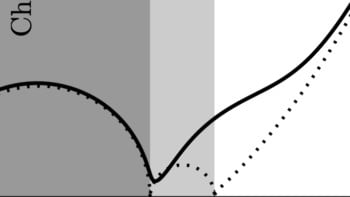
A simple study of how loops of ribbon respond when tightened has revealed a variety of different behaviours, according to physicists in Japan. Their results could help to explain biological phenomena such as how proteins interact with DNA or how pea-tendrils climb.
“The ribbon shape is very common,” says Hirofumi Wada, a physicist at Ritsumeikan University in Japan. Ribbon-shaped phenomena range from helical bacteria to proteins and nanomaterials. “To study many biological problems, we have to understand more deeply the basic properties of ribbon-like objects,” he says.
The experiment performed by Wada and colleagues was straightforward: put a loop in a paper ribbon, clamp it at both ends and pull on the loop to see what happens. “We thought in the beginning that somebody had already done it,” Wada says. “Somebody should have already done it.”
Non-intuitive behaviour
Although a ribbon appears simple, its behaviour is actually considerably more complicated than a 1D wire, explains Julien Chopin of ESPCI in France, who was not involved in the research. Unlike a wire, a ribbon has an extra dimension – its width. While bending a ribbon like a wire is easy, it is difficult to bend it along this extra dimension. Chopin says this extra constraint on the ribbon’s geometry results in complicated, non-intuitive behaviour.
In real life, all filaments have some width, so it is not always clear whether a flat, long filament behaves more like a 1D wire or a 2D ribbon. Wada and his colleagues found the parameter that classified a looped filament as ribbon-like rather than wire-like is the ratio of the filament’s width to the height of the loop.
It’s fun for basically anybody, not just scientists
Hirofumi Wada, Ritsumeikan University
They found that depending on the loop’s initial configuration, pulling on it could result in three different geometrical shapes. The loop could shrink until it formed a “kink”, which creased the paper. The loop could also form two types of twisted shapes called a “helicoid” and a “pop-out”, both of which do not crease the paper. By performing this experiment thousands of times with thousands of paper ribbons, they found which geometrical conditions would result in the crease, the helicoid or the pop-out.
The researchers also discovered that the loop’s behaviour depends only on the geometry of the ribbon and not its material. “However, at the same time, we are not yet sure whether this property is really universally applicable,” says Wada.
Scale models
These macroscopic ribbons serve as a practical scale model for studying the physics of microscopic ribbons. Although they are much larger than structures found in bacteria or nanostructures, paper ribbons are much easier to control and manipulate. “With this kind of macroscopic experiment, you can measure almost anything easily,” Chopin says. “You can build an understanding of microscopic ribbons from them.”
Furthermore, Wada says, paper is cheap. “Also, it’s fun for basically anybody, not just scientists,” he adds. Wada keeps several ribbon-shaped toys in his office, such as a helical rainbow streamer dangling from his office ceiling.
The team’s next step is to try the experiment with different materials to better understand how elasticity affects the pulled-loop’s geometry. The researchers have already begun similar experiments to study loops using rubber bands.
The experiments are described in Physical Review Letters.



